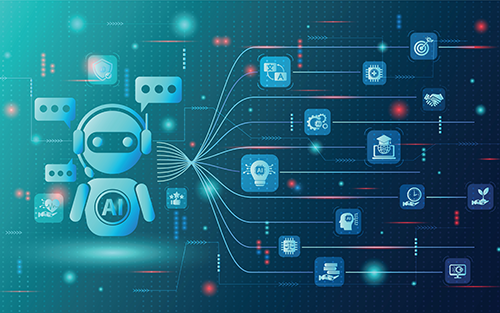
Summary
NVIDIA’s Omniverse forms the portal to a future where digital efficiencies unite to overcome physical obstacles on the factory floor.
How to Cross the Agentic AI Bridge to Physical AI in Manufacturing
The rapid maturation of the NVIDIA Omniverse platform is proof that Agentic AI and Physical AI are more than fleeting trends for the manufacturing industry. Let’s discuss what agentic AI is and how to apply it in manufacturing through the Omniverse platform, which is an operating system that connects the world’s physical data to the realm of physical AI.
A journey from building machines to developing software
I started my career building machines—literally. From the trenches of robotics automation (installing laser CNC systems, programming factory-floor robotics and troubleshooting everything from sensors to software) to the transition from applications engineering and eventually into software development, the path of my career has often looked unconventional yet purpose-driven, until NVIDIA Omniverse and the expansion of AI entered the picture.
This convergence is happening as economic and political turmoil intersects with the rising demand for efficient production, positioning Omniverse as a pragmatic and advantageous option for manufacturers.
As we play “follow the leader” over the bridge from Agentic AI to Physical AI, Omniverse forms the portal to a future where digital efficiencies unite to overcome physical obstacles on the factory floor.
What is Agentic AI, and why should manufacturers care?
The evolution of AI has flooded industrial markets over the last decade; we witnessed Perception AI enable machine vision, quality inspection and recognition tasks. Then came Generative AI with contextual content creation and simulations on demand. These led to industry successes like enhanced safety support and streamlined equipment manuals with industrial assistants.
Agentic AI goes beyond perceiving and generating; this type of artificial intelligence plans, makes decisions, uses tools and executes tasks autonomously—without being told what to do and without coding. It can give manufacturing systems the option to self-optimize, adapt and operate.
Consider a laser CNC machine cutting sheet metal for industrial equipment, silverware or a variety of random uses like the metal parts on toy train tracks. Back then, it was always a dance to find that optimal setting to get a good clean cut. Multiple factors would contribute to a non-optimal product, such as the gas, mirror alignment and quality of the fiber optic cable used in the process. The settings of each could be dialed in one day and completely changed the next, reverting progress back to square one.
Imagine if the system understood the context of the environment and could reconfigure itself based on the uniqueness of that machine, gas flow, optical alignments, tool health or part geometry, without being told exactly how.
This is not a distant idea. Agentic AI makes this not only realistic but also scalable and impactful.
Why this matters: The road to physical AI
Agentic AI is not the destination; it’s the bridge connecting the industry to Physical AI and the ability to access systems that understand friction, gravity, spatial relationships and real-world cause and effect. To operate robotics in dynamic physical environments, AI must understand the laws of physics. To do so requires training and reasoning in environments that mirror the real world.
What is NVIDIA Omniverse?
Enter NVIDIA Omniverse.
Rev Lebaredian, VP of Omniverse and Simulation at NVIDIA, put it well: “Omniverse is an operating system that connects the world’s physical data to the realm of physical AI.”
Built on OpenUSD, Omniverse is a platform that enables real-time 3D collaboration and physics-based simulations by leveraging the power of NVIDIA RTX GPUs. As a precursor to Physical AI, it serves as an operating system for both humans and intelligent agents to design, test and optimize within the virtual world.
This approach then leads to less physical prototypes, costly mistakes and wasted engineering hours in the physical world, resulting in lower production costs and faster development.
At the core, Omniverse is not replacing anything but rather creating a collaborative environment where companies like Siemens, Ansys, Databricks and SAP are integrating their workflows to lay the foundation for Physical AI. Some companies are even starting to think outside the box with questions like “what if my software understands USD natively?” as they get closer to the next stage.
Omniverse: The missing infrastructure
The building blocks of Physical AI were forged with the rise and evolution of digital twins and the industrial metaverse. I remember the first digital twin I created on the Omniverse platform to generate synthetic data for part defects in an automotive assembly line: in modifying the texture on the 3D asset to create different edge cases and annotating the frame automatically, we increased detection results and decreased time spent deep in datasets. And while the innovative advantages of the industrial metaverse were ample, the process still lacked autonomy.
Generative AI has since helped simplify the process further, but now Agentic AI hands the metaphorical remote controller to the digital twin to run tests, validate logic, predict failures, and learn continuously using the new data.
So how does this all connect?
- Agentic AI needs a world to reason within.
- Digital Twins provide that world.
- Omniverse is the infrastructure that connects them all.
With OpenUSD as the interoperability backbone, Omniverse allows diverse tools, datasets and simulations to interoperate. It’s where AI can learn, reason and ultimately control the physical world from its digital walls to deployment. Essentially, the simulation-first approach helps ease the nerves of manufacturers before putting the pedal to the metal toward its final destination: Physical AI.
The inevitable future of manufacturing
I used to think I’d left my manufacturing background behind when I pivoted to software. But now I see it prepared me for this exact moment where the physical and digital worlds converge.
In a reimagining of what intelligent systems can do when grounded in both code and context, manufacturers must take note: NVIDIA Omniverse is the key, the portal, the missing infrastructure emerging as an enabler for cost-optimized facility planning and execution that fosters an environment for industrial innovation and the inevitability of Physical AI. It is the infrastructure the manufacturing industry will rely on to bridge the gap between Agentic AI and Physical AI in what will be seen as foundational shifts for the future of manufacturing.
About The Author
 Mike Wisniewski is the Omniverse Enterprise Solutions Consultant at SoftServe. He specializes in harnessing the power of Generative AI and digital twins within the dynamic landscape of 3D environments. Wisniewski has nearly 10 years of experience developing cutting-edge solutions with a diverse background in robotics, industrial automation and software development. Prior to SoftServe, Wisniewski spent time in the military before building a robust foundation for software engineering with notable projects like Unity solution architecture at Slalom and microservice architecture at J.P. Morgan.
Mike Wisniewski is the Omniverse Enterprise Solutions Consultant at SoftServe. He specializes in harnessing the power of Generative AI and digital twins within the dynamic landscape of 3D environments. Wisniewski has nearly 10 years of experience developing cutting-edge solutions with a diverse background in robotics, industrial automation and software development. Prior to SoftServe, Wisniewski spent time in the military before building a robust foundation for software engineering with notable projects like Unity solution architecture at Slalom and microservice architecture at J.P. Morgan.
SoftServe is an IT consulting and digital services provider. Clients confidently rely on SoftServe to architect and execute mature and innovative capabilities, such as digital engineering, data and analytics, cloud, and AI/ML. For more than 30 years, the company has developed and delivered digital solutions at exceptional speed across enterprise industries, including high tech, financial services, healthcare, life sciences, retail, energy and manufacturing.
Did you enjoy this great article?
Check out our free e-newsletters to read more great articles..
Subscribe






